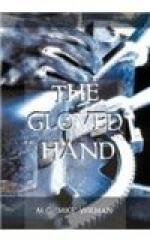“She’s a beautiful girl,” I concluded, “and very young. I agree with Swain that she mustn’t be left alone in that house.”
“Certainly she mustn’t,” said my partner. “I’ll have Mrs. Royce write the note, and get a room ready for her.”
“Of course,” I said, “it’s possible she won’t come—though I believe she’ll be glad to. Or there may be a family lawyer who will want to look after her. Only she didn’t appear to know of any when she was talking to Swain.”
“Well, bring her along if you can,” said Mr. Royce. “We’ll be glad to have her. And take your time about coming back, if you’re needed up there. We’re getting along all right.”
I thanked him, and hung up; and presently Mrs. Hargis came to summon me to dinner. That meal over, I went in to Godfrey’s desk to see what the books were he had suggested that I look at. There was quite a pile of them, and I saw that they all related to mysticism or to the religions of India. There was Sir Monier Williams’s “Brahmanism and Hinduism,” Hopkins’s “The Religions of India,” a work on crystallomancy, Mr. Lloyd Tuckey’s standard work on “Hypnotism and Suggestion,” and some half dozen others whose titles I have forgotten. And as I looked at them, I began to understand one reason for Godfrey’s success as a solver of mysteries—no detail of a subject ever escaped him.
I lit my pipe, sat down, and was soon deep in the lore of the East. I must confess that I did not make much of it. In that maze of superstition, the most I could do was to pick up a thread here and there. The yogi had referred to the White Night of Siva, and I soon found out that Siva is one of the gods of Hinduism—one of a great trilogy: Brahma the creator, Vishnu the preserver, and Siva the destroyer. He had also spoken of the attributes of Kali, and, after a little further search, I discovered that Kali was Siva’s wife—a most unprepossessing and fiendish female.
But when I passed on to Hinduism itself, and tried to understand its tenets and its sects, I soon found myself out of my depth. They were so jumbled, so multitudinous, and so diverse that I could get no clear idea of them. I read of the Vedas, the Upanishads, the Brahmanas; of metaphysical abstractions too tenuous to grasp; of karna or action, of maya or illusion, and I know not what “tangled jumble of ghosts and demons, demi-gods, and deified saints, household gods, village gods, tribal gods, universal gods, with their countless shrines and temples and din of discordant rites.” At last, in despair, I gave it up, and turned to the book on crystallomancy.
Here, at least, was something comprehensible, if not altogether believable, and I read with interest of the antiquity of crystal-gazing as a means of inducing hallucination for the purpose of seeking information not to be gained by any normal means. I read of its use in China, in Assyria, in Egypt, in Arabia, in India, in Greece and Rome; of how its practitioners in the Middle Ages were looked upon as heretics and burnt at the stake or broken on the wheel; of the famous Dr. Dee, and so down to the present time. The scryers or seers sometimes used mirrors, sometimes vessels filled with water, but usually a polished stone, and beryl was especially esteemed.




